The global kitting robots market is projected to grow from USD 1.9 billion in 2025 to approximately USD 2.6 billion by 2035, recording an absolute increase of USD 0.8 billion over the forecast period. This translates into a total growth of 41.5%, with the market forecast to expand at a compound annual growth rate (CAGR) of 3.5% between 2025 and 2035. The overall market size is expected to grow by nearly 1.41X during the same period, supported by increasing automation adoption in manufacturing operations, growing demand for collaborative robotic solutions, and rising emphasis on material handling efficiency across various regional markets.
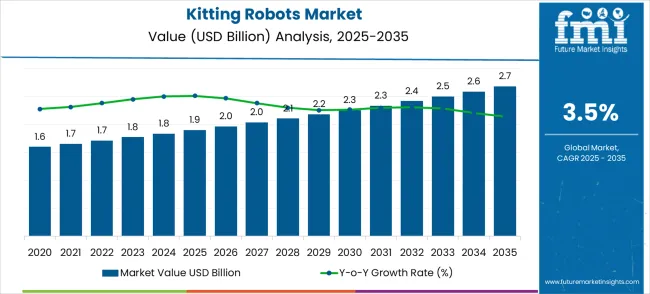
Between 2025 and 2030, the kitting robots market is projected to expand from USD 1.9 billion to USD 2.3 billion, resulting in a value increase of USD 0.4 billion, which represents 45.3% of the total forecast growth for the decade. This phase of development will be shaped by accelerating collaborative robotics adoption, requiring advanced material handling solutions, increasing demand for automated kitting systems in automotive manufacturing, and growing deployment of autonomous mobile robots across industrial facilities. Original equipment manufacturers are investing in advanced payload handling technologies to improve operational efficiency and meet evolving Industry 4.0 requirements in manufacturing and assembly sectors.
From 2030 to 2035, the market is forecasted to grow from USD 2.3 billion to USD 2.6 billion, adding another USD 0.3 billion, which constitutes 13.0% of the overall ten-year expansion. This period is expected to be characterized by the widespread adoption of AMR with onboard arm configurations, the integration of smart technologies in robotic kitting systems, and a massive growth in manufacturing automation driven by increasing demand for flexible production solutions. The growing focus on operational flexibility will drive demand for high-quality kitting robots across both automotive and electronics applications.
Between 2020 and 2025, the kitting robots market experienced steady expansion, driven by recovering manufacturing activity following global economic disruptions and growing recognition of automation's importance in material handling efficiency and operational cost reduction. The market developed as manufacturing companies recognised the need for reliable and flexible robotic systems to support automated assembly processes and meet production requirements while maintaining operational standards.
| Metric | Value |
|---|---|
| Market Value (2025) | USD 1.9 billion |
| Market Forecast Value (2035) | USD 2.6 billion |
| Forecast CAGR (2025-2035) | 3.5% |
Market expansion is being supported by the continuous growth of manufacturing automation across established and emerging markets and the corresponding need for efficient material handling equipment that ensures optimal production performance and operational cost effectiveness. Modern manufacturing operations require sophisticated robotic systems that can deliver precise component handling, reduced manual labour dependency, and enhanced operational efficiency while operating under diverse production requirements and quality standards. The superior flexibility and accuracy characteristics of high-quality kitting robots make them essential equipment in manufacturing operations where material handling performance directly impacts production efficiency and operational productivity.
The growing emphasis on Industry 4.0 implementation and collaborative robotics adoption is driving demand for advanced kitting automation from certified manufacturers with proven track records of quality and reliability in manufacturing applications. Manufacturing companies and system integrators are increasingly investing in premium kitting robot systems that offer extended service life while maintaining consistent handling performance and operational flexibility. Regulatory requirements and manufacturing standards are establishing performance benchmarks that favour high-quality robotic equipment with superior engineering properties and resistance to operational stresses.
The market is segmented by solution type, payload class, industry, delivery model, and region. By solution type, the market is divided into cobot workcells, AMR with onboard arm, industrial robot bin-pick, and AS/RS-integrated configurations. Based on payload class, the market is categorised into less than 5 kg, 5-15 kg, and greater than 15 kg segments. By industry, the market includes automotive, electronics, general manufacturing, and aerospace. By delivery model, applications span system integrator turnkey, OEM direct, and RaaS/outsourced. Regionally, the market is divided into North America, Europe, East Asia, South Asia & Pacific, Latin America, and the Middle East & Africa.
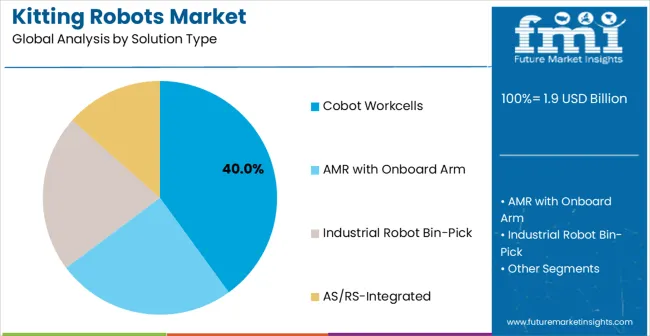
Cobot Workcells solution configurations are projected to account for 40% of the kitting robots market in 2025. This leading share is supported by the collaborative nature and integration flexibility of cobot workcell systems in manufacturing applications and the widespread preference for human-robot collaboration in production environments. Cobot workcells offer excellent safety characteristics and operational adaptability, making them ideal for diverse manufacturing operations and challenging production environments where flexibility and collaborative operation are essential. The segment benefits from technological advancements that have improved safety features, programming simplicity, and deployment speed.
Modern cobot workcells incorporate advanced collaborative robotics technologies, precision-engineered safety systems, and specialised programming interfaces that deliver exceptional material handling performance while maintaining operational safety and flexibility under demanding manufacturing conditions. These innovations have significantly improved manufacturing productivity while maintaining compatibility with existing production workflows and reducing implementation complexity through enhanced user-friendly interfaces and safety protocols. The automotive and electronics sectors particularly drive demand for cobot workcell solutions, as manufacturing facilities require flexible automation equipment that can meet stringent performance standards and safety requirements.
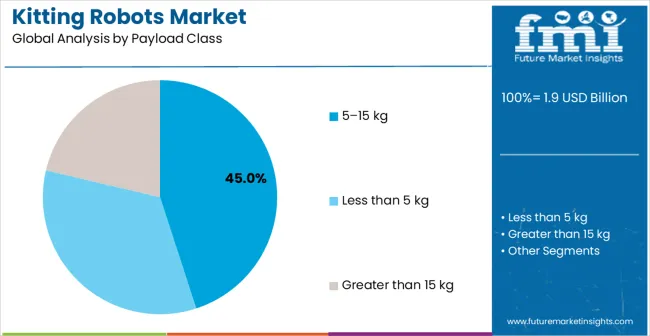
Medium payload (5-15 kg) applications are expected to represent 45% of kitting robots demand in 2025. This significant share reflects the optimal balance between handling capability and operational flexibility for most manufacturing applications globally and the need for versatile robotic systems that meet medium-duty material handling requirements. Medium payload operations require consistent supplies of kitting robots for automotive assembly, electronics manufacturing, and general industrial applications across diverse operational environments and production specifications. The segment benefits from ongoing manufacturing automation growth and increasing emphasis on payload optimisation and operational efficiency in robotic material handling.
Medium payload applications demand exceptional equipment reliability to ensure consistent handling performance throughout operational periods while meeting stringent manufacturing standards and quality control requirements. These applications require kitting robots capable of withstanding continuous operation, load variations, and long-term service under demanding conditions and production schedules. The growing emphasis on operational efficiency and cost effectiveness, particularly in automotive and electronics manufacturing, requiring versatile robotic systems for component handling and assembly line feeding, drives consistent demand for high-quality medium payload equipment.
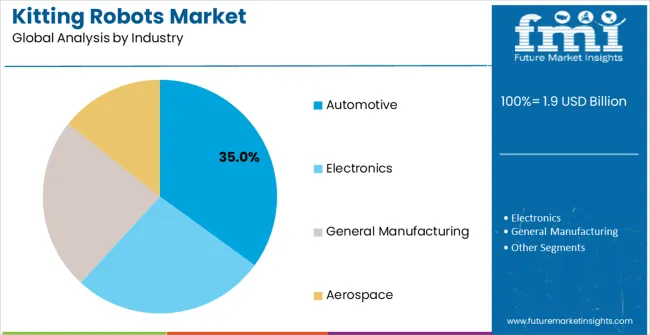
Automotive applications are projected to account for 35% of the kitting robots market in 2025. This substantial share is supported by the industry's high automation adoption rate and complex material handling requirements that drive demand for advanced robotic kitting solutions. Automotive applications require robust and precise robotic equipment that can perform across varying component handling requirements while maintaining operational efficiency and consistency in quality. The segment benefits from the increasing complexity of automotive manufacturing processes and growing investments in production automation.
Modern automotive applications demand kitting robots that offer superior handling precision, reduced cycle times, and enhanced integration capabilities to support diverse automotive manufacturing requirements and production specifications. These facilities operate under strict quality standards and production schedules, requiring equipment that can adapt to different component types while maintaining consistent performance and manufacturing quality. The growing emphasis on lean manufacturing and zero-defect production drives demand for automotive manufacturers who can provide comprehensive robotic solutions with proven track records of operational excellence and quality reliability.
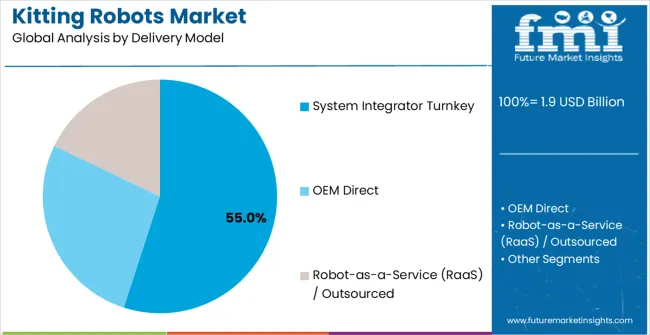
System Integrator Turnkey delivery models are projected to account for 55% of the kitting robots market in 2025. This substantial share is supported by the preference for comprehensive automation solutions and the increasing need for complete system implementation that reduces deployment complexity. System integrator turnkey applications require experienced solution providers that can deliver integrated robotic systems while maintaining operational efficiency and project management effectiveness. The segment benefits from the increasing complexity of robotic automation projects and the growing demand for single-source accountability.
Modern system integrators' turnkey applications demand comprehensive project management, reduced implementation risk, and enhanced support capabilities to support diverse manufacturing requirements and customer specifications. These delivery models operate under demanding project timelines and performance expectations, requiring providers that can adapt to different customer requirements while maintaining consistent project quality and system performance. The growing emphasis on operational simplicity and comprehensive support drives demand for system integrators who can provide complete automation solutions with proven track records of successful implementation and ongoing service excellence.
The kitting robots market is advancing steadily due to continuing manufacturing automation growth and increasing recognition of robotic material handling's importance in operational efficiency and cost reduction. However, the market faces challenges, including integration complexity affecting deployment timelines, skilled workforce requirements for system operation and maintenance, and varying manufacturing requirements across different industry applications affecting system standardisation. Customisation needs and real-time connectivity requirements continue to influence system design and market development patterns.
The growing deployment of collaborative robotic systems, mobile platform integration, and flexible automation solutions is enabling superior operational adaptability and enhanced safety characteristics in kitting robot applications. Advanced collaborative systems and mobile integration provide enhanced operational flexibility, reduced safety complexity, and improved production adaptability compared to traditional fixed robotic systems. These innovations are particularly valuable for manufacturing operations that require reliable equipment capable of meeting changing production requirements and demanding operational conditions.
Modern kitting robot manufacturers are incorporating manufacturing execution system connectivity and enterprise resource planning integration that provide enhanced production coordination and reduced operational complexity compared to standalone robotic systems. Integration of real-time data analytics, inventory management systems, and predictive maintenance creates opportunities for advanced robotic equipment that supports both high-performance material handling and operational optimisation requirements. Advanced connectivity technologies and data management systems also support the development of more sophisticated automation solutions for modern manufacturing applications.
| Country | CAGR (2025 to 2035) |
|---|---|
| China | 4.5% |
| Brazil | 4.3% |
| India | 4.1% |
| United States | 3.2% |
| Germany | 3.0% |
The kitting robots market is growing steadily, with China leading at a 4.5% CAGR through 2035, driven by massive manufacturing automation expansion, increasing robotics adoption in automotive and electronics sectors, and comprehensive Industry 4.0 implementation programs supporting both domestic consumption and export manufacturing. Brazil follows at 4.3%, supported by industrial modernisation initiatives, expanding automotive production capabilities, and increasing focus on manufacturing competitiveness serving domestic and regional markets. India records growth at 4.1%, emphasising electronics manufacturing expansion, automotive sector development, and operational excellence in manufacturing automation operations. The United States shows growth at 3.2%, focusing on advanced manufacturing, strengthening and the aerospace industry automation. Germany maintains expansion at 3.0%, supported by Industry 4.0 leadership and precision manufacturing expertise.
The report covers an in-depth analysis of 40+ countries; five top-performing countries are highlighted below.
Revenue from kitting robots in China is projected to exhibit the highest growth rate with a CAGR of 4.5% through 2035, driven by massive manufacturing automation expansion and comprehensive robotics adoption, creating substantial opportunities for robotic material handling suppliers across automotive manufacturing, electronics production, and industrial automation sectors. The country's growing manufacturing automation capacity and expanding robotics infrastructure are creating significant demand for both collaborative and industrial robotic kitting systems. Major manufacturing companies and automation integrators are establishing comprehensive local equipment procurement to support large-scale operations and meet growing demand for efficient robotic material handling solutions.
Revenue from kitting robots in Brazil is expanding at a CAGR of 4.3%, supported by extensive industrial modernisation programs and comprehensive automotive manufacturing development, creating sustained demand for reliable robotic automation across diverse industrial categories and manufacturing segments. The country's expanding automotive sector and growing automation capabilities are driving demand for robotic equipment that provides consistent performance while supporting cost-effective operational requirements. Robotic automation manufacturers are investing in local production facilities to support growing manufacturing operations and industrial automation demand.
Demand for kitting robots in India is projected to grow at a CAGR of 4.1%, supported by the country's expanding electronics manufacturing sector and comprehensive automation initiatives requiring sophisticated robotic systems for production and assembly operations. Indian manufacturing companies are implementing advanced robotic solutions that support diverse manufacturing techniques, operational efficiency, and comprehensive quality management. The market is characterised by a focus on operational excellence, system reliability, and compliance with international manufacturing performance standards.
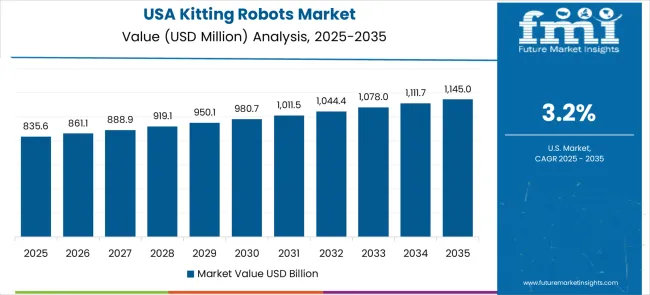
Revenue from kitting robots in the United States is growing at a CAGR of 3.2%, driven by advanced manufacturing strengthening initiatives and aerospace industry automation, creating sustained opportunities for robotic automation suppliers serving both aerospace and automotive manufacturing sectors. The country's established manufacturing infrastructure and advanced automation capabilities are creating demand for robotic equipment that supports diverse operational requirements while maintaining performance standards. Manufacturing companies and system integrators are developing equipment procurement strategies to support operational efficiency and competitive positioning.
Demand for kitting robots in Germany is expanding at a CAGR of 3.0%, driven by Industry 4.0 leadership programs and precision manufacturing expertise, creating opportunities for robotic automation suppliers serving both automotive and advanced manufacturing sectors. The country's established robotics expertise and manufacturing excellence are creating demand for high-quality robotic equipment that supports operational performance and technological leadership. Equipment manufacturers and automation suppliers are maintaining comprehensive development capabilities to support diverse manufacturing requirements.
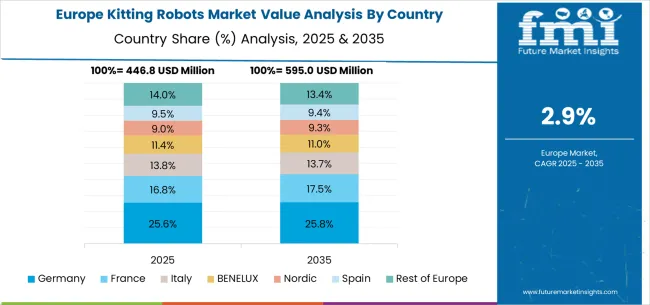
The kitting robots market in Europe is projected to grow from USD 0.5 billion in 2025 to USD 0.7 billion by 2035, registering a CAGR of 3.1% over the forecast period. Germany is expected to maintain its leadership position with a 35.2% market share in 2025, remaining stable at 35.0% by 2035, supported by its advanced robotics manufacturing sector, Industry 4.0 expertise, and comprehensive automation innovation serving European and international manufacturing markets.
The United Kingdom follows with a 22.8% share in 2025, projected to reach 23.1% by 2035, driven by manufacturing automation initiatives, advanced robotics technology development capabilities, and a growing focus on operational efficiency solutions for premium manufacturing operations. France holds an 18.4% share in 2025, expected to maintain 18.2% by 2035, supported by automotive manufacturing demand and advanced robotics technology applications, but facing challenges from market competition and economic considerations.
Italy commands a 12.6% share in 2025, projected to reach 12.8% by 2035, while Spain accounts for 7.3% in 2025, expected to reach 7.5% by 2035. The Netherlands maintains a 3.7% share in 2025, growing to 3.8% by 2035. The Rest of Europe region, including Nordic countries, Eastern Europe, Belgium, Switzerland, and Austria, is anticipated to hold 18.6% in 2025, declining slightly to 18.4% by 2035, attributed to mixed growth patterns with strong expansion in some Nordic manufacturing automation markets balanced by moderate growth in smaller countries implementing manufacturing modernisation programs.
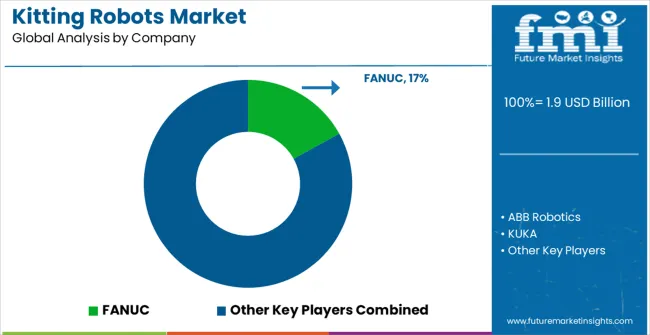
The kitting robots market is defined by competition among established robotics manufacturers, specialised automation system providers, and emerging collaborative robotics firms. Companies are investing in advanced robotic technology, manufacturing process optimisation, integration capabilities, and global service networks to deliver reliable, flexible, and cost-effective robotic automation solutions. Strategic partnerships, technological advancement, and geographic expansion are central to strengthening product portfolios and market presence.
ABB Robotics, operating globally, offers comprehensive robotic automation solutions with a focus on advanced technology, operational excellence, and manufacturing industry partnerships, maintaining a leading market position. FANUC provides specialised robotic equipment with emphasis on precision engineering and operational reliability. KUKA, a German robotics specialist, delivers advanced automation technologies with a focus on collaborative robotics and automotive manufacturing applications. These leading companies demonstrate strong market presence through technological innovation and comprehensive service capabilities.
Established robotics providers include Universal Robots, offering specialised collaborative robotic solutions with a focus on operational safety and programming simplicity. Yaskawa Motoman delivers comprehensive robotic systems with emphasis on industrial applications and technical support. Comau provides robotic equipment with a focus on automotive manufacturing applications and system integration capabilities. Epson Robots offers specialised automation solutions with emphasis on precision manufacturing and regional market development.
Emerging market participants include Kawasaki Robotics, Omron Robotics, and Stäubli Robotics, offering specialised robotic automation expertise, innovative technologies, and technical support across global and regional manufacturing markets, with a focus on advanced automation capabilities and operational efficiency solutions.
The kitting robots market underpins manufacturing automation advancement, operational efficiency optimisation, production flexibility improvement, and industrial competitiveness. With manufacturing automation growth, advancing robotic technologies, and increasing operational requirements, the sector must balance equipment quality, system flexibility, and cost competitiveness. Coordinated contributions from governments, manufacturing associations, equipment manufacturers, system integrators, and investors will accelerate the transition toward advanced, reliable, and highly efficient robotic automation systems.
| Items | Values |
|---|---|
| Quantitative Units | USD 1.9 billion |
| Solution Type | Cobot Workcells, AMR with Onboard Arm, Industrial Robot Bin-Pick, AS/RS-Integrated |
| Payload Class | <5 kg, 5-15 kg, >15 kg |
| Industry | Automotive, Electronics, General Manufacturing, Aerospace |
| Delivery Model | System Integrator Turnkey, OEM Direct, RaaS/Outsourced |
| Regions Covered | North America, Europe, East Asia, South Asia & Pacific, Latin America, Middle East & Africa |
| Country Covered | United States, Canada, United Kingdom, Germany, France, China, Japan, South Korea, Brazil, Australia and 40+ countries |
| Key Companies Profiled | ABB Robotics, FANUC, KUKA, Universal Robots, Yaskawa Motoman, Comau, Epson Robots, Kawasaki Robotics, Omron Robotics, Stäubli Robotics |
| Additional Attributes | Dollar sales by solution type/payload class, regional demand trends, competitive landscape, collaborative vs. industrial robotics adoption, manufacturing execution system integration, payload flexibility innovations, and automation solutions driving manufacturing efficiency, operational cost reduction, and production flexibility optimisation |
The global kitting robots market is estimated to be valued at USD 1.9 billion in 2025.
The market size for the kitting robots market is projected to reach USD 2.7 billion by 2035.
The kitting robots market is expected to grow at a 3.5% CAGR between 2025 and 2035.
The key product types in kitting robots market are cobot workcells, amr with onboard arm, industrial robot bin-pick and as/rs-integrated.
In terms of payload class, 5–15 kg segment to command 45.0% share in the kitting robots market in 2025.






Our Research Products

The "Full Research Suite" delivers actionable market intel, deep dives on markets or technologies, so clients act faster, cut risk, and unlock growth.

The Leaderboard benchmarks and ranks top vendors, classifying them as Established Leaders, Leading Challengers, or Disruptors & Challengers.

Locates where complements amplify value and substitutes erode it, forecasting net impact by horizon

We deliver granular, decision-grade intel: market sizing, 5-year forecasts, pricing, adoption, usage, revenue, and operational KPIs—plus competitor tracking, regulation, and value chains—across 60 countries broadly.

Spot the shifts before they hit your P&L. We track inflection points, adoption curves, pricing moves, and ecosystem plays to show where demand is heading, why it is changing, and what to do next across high-growth markets and disruptive tech

Real-time reads of user behavior. We track shifting priorities, perceptions of today’s and next-gen services, and provider experience, then pace how fast tech moves from trial to adoption, blending buyer, consumer, and channel inputs with social signals (#WhySwitch, #UX).

Partner with our analyst team to build a custom report designed around your business priorities. From analysing market trends to assessing competitors or crafting bespoke datasets, we tailor insights to your needs.
Supplier Intelligence
Discovery & Profiling
Capacity & Footprint
Performance & Risk
Compliance & Governance
Commercial Readiness
Who Supplies Whom
Scorecards & Shortlists
Playbooks & Docs
Category Intelligence
Definition & Scope
Demand & Use Cases
Cost Drivers
Market Structure
Supply Chain Map
Trade & Policy
Operating Norms
Deliverables
Buyer Intelligence
Account Basics
Spend & Scope
Procurement Model
Vendor Requirements
Terms & Policies
Entry Strategy
Pain Points & Triggers
Outputs
Pricing Analysis
Benchmarks
Trends
Should-Cost
Indexation
Landed Cost
Commercial Terms
Deliverables
Brand Analysis
Positioning & Value Prop
Share & Presence
Customer Evidence
Go-to-Market
Digital & Reputation
Compliance & Trust
KPIs & Gaps
Outputs
Full Research Suite comprises of:
Market outlook & trends analysis
Interviews & case studies
Strategic recommendations
Vendor profiles & capabilities analysis
5-year forecasts
8 regions and 60+ country-level data splits
Market segment data splits
12 months of continuous data updates
DELIVERED AS:
PDF EXCEL ONLINE
SLAM Robots Market Size and Share Forecast Outlook 2025 to 2035
Micro Robots Market Analysis - Size, Share, and Forecast Outlook 2025 to 2035
Delta Robots Market
Mobile Robots Market Size and Share Forecast Outlook 2025 to 2035
Pharma Robots Market Size and Share Forecast Outlook 2025 to 2035
Nuclear Robots Market Size and Share Forecast Outlook 2025 to 2035
Milking Robots Market Size and Share Forecast Outlook 2025 to 2035
Airport Robots Market Size and Share Forecast Outlook 2025 to 2035
Painting Robots Market Size and Share Forecast Outlook 2025 to 2035
Security Robots Market Size and Share Forecast Outlook 2025 to 2035
Military Robots Market Size and Share Forecast Outlook 2025 to 2035
Surgical Robots Market
Pipetting Robots Market Size and Share Forecast Outlook 2025 to 2035
Logistics Robots Market Size and Share Forecast Outlook 2025 to 2035
Inspection Robots Market Size and Share Forecast Outlook 2025 to 2035
Dispensing Robots Market Size and Share Forecast Outlook 2025 to 2035
Palletizing Robots Market Size and Share Forecast Outlook 2025 to 2035
Therapeutic Robots Market Size and Share Forecast Outlook 2025 to 2035
Educational Robots Market Analysis by Type, Application, and Region Through 2035
AI Assisted Robots Market

Thank you!
You will receive an email from our Business Development Manager. Please be sure to check your SPAM/JUNK folder too.
Chat With
MaRIA